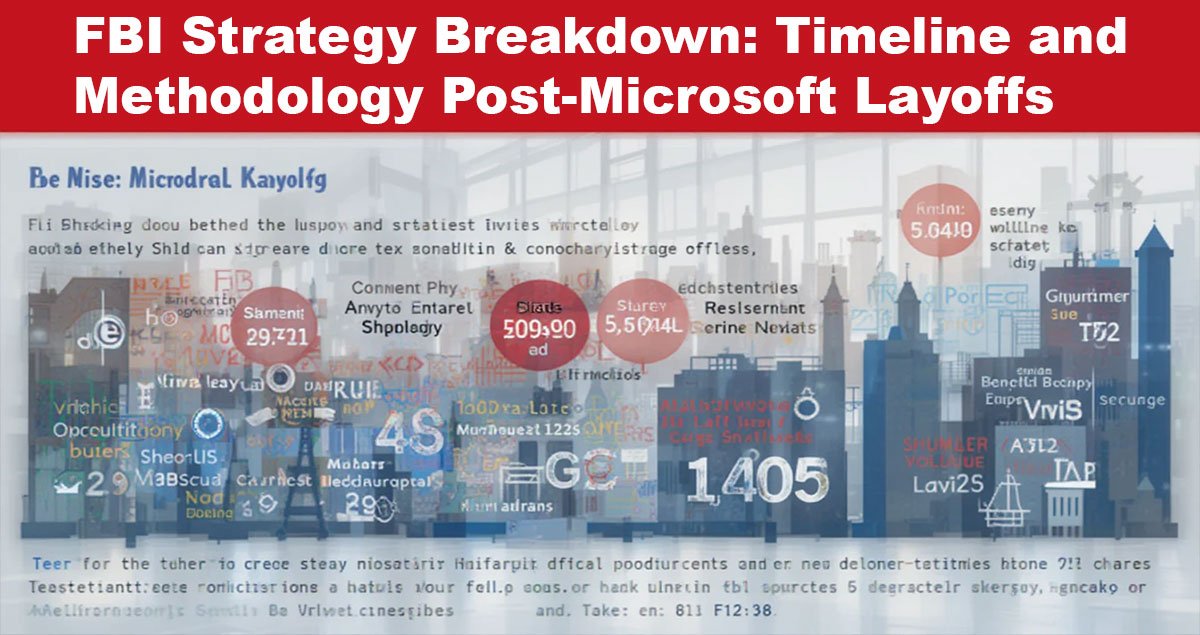In 2025, Microsoft’s blind layoffs—unexpected job cuts without warning—created not just corporate chaos but a golden opportunity for the FBI to gather intelligence by leveraging vulnerable employees, internal leaks, and weakened systems. This article uncovers how federal agents quietly exploit these moments of disruption to access sensitive information, investigate deeper threats, and use silence and confusion as tools of surveillance.
With the insights of former agents, whistleblowers, and legal experts at its support, it unveils a rising encroachment between Big Tech and federal power, where the trust among employees gets broken, transparency is lost, and layoffs are no more mere staffing decisions but triggers of national security.
The Shocking Truth Behind Microsoft’s Blind Layoffs in 2025
What Are Blind Layoffs? Breaking Down the Corporate Code of Silence
Blind layoffs aren’t just your average job cuts. They’re sudden, unexpected terminations delivered with minimal communication. No warning, no performance review trails, and no clear rationale. Employees log in one day to find their access revoked. Managers go silent. HR responses are vague. It’s as if the employee never existed.

In 2025, Microsoft’s blind layoffs hit hard. Employees across teams—from Azure to LinkedIn—were terminated without advance notice. What was especially disturbing was not even the number (almost 7 thousand employees worldwide), but the way it was – is. A fast, silent, and informal manner, and with no prior communication. It sent a very frightening message, not only in the company but the entire tech industry.
These kinds of layoffs create a vacuum. No context, no closure. For laid-off staff, it triggers not just financial panic but emotional and psychological distress. Confusion leads to anger, and in this chaos, former employees often seek outlets—some speak out, some share internal secrets, and others might even turn to authorities.
And here’s the thing—that’s exactly the kind of chaos the FBI watches for.
Why Microsoft’s 2025 Layoff Strategy Sent Shockwaves Through the Tech World
Microsoft isn’t new to restructuring. But the 2025 wave was different. The layoffs didn’t follow any clear business downturn. Revenue was steady. Productivity was up. There were no public earnings failures. Yet, nearly 3% of the global workforce was slashed.
So why now?
Insiders speculate that these layoffs were a strategic realignment. Some even whisper about deeper motives—cost-cutting before regulatory crackdowns, prepping for AI workforce integration, or masking internal investigations. But regardless of the motive, the method—a lack of transparency and blind execution—sparked concerns.
Tech giants usually handle layoffs with town halls, transition programs, or at least internal memos. This time, silence was the strategy.
That silence made headlines.
And it drew more than just media attention. The FBI, already monitoring cybersecurity trends and internal whistleblower activity in tech firms, zeroed in. Because where there’s disruption, there’s often data—unguarded, leaked, or willingly offered by employees desperate for justice or revenge.
The Emotional Fallout: Real Voices from the Microsoft Workforce
You can crunch numbers all day, but layoffs aren’t just statistics—they’re people. And the emotional toll of a blind layoff is profound.
Former employees described feelings of betrayal. One product manager wrote on LinkedIn, “We gave everything to this company. Overnight, we were ghosts.” Another, a software engineer, shared that he only learned of his termination when his email stopped working and his badge was declined at the office.
There was no call. No email. No thank-you-for-your-service. Just a digital erasure.
This sudden severance pushed many into anxiety, depression, and deep mistrust—not just of Microsoft but of Big Tech as a whole. With no explanation, these professionals began to speculate: Why me? Was it my project? My politics? My whistleblowing?
Some went public. Some contacted journalists. Others turned to lawyers.
And a select few? They reached out to the FBI.
Why the FBI Cares: The Secret Connection Between Layoffs and Intelligence
Surveillance Windows: How Chaos Creates Opportunity for Federal Agencies
Here’s where things get interesting.
The FBI isn’t interested in layoffs for the sake of HR. They’re watching for when chaos cracks open the well-guarded vaults of corporate America. In the storm that follows blind layoffs, employees often say things they wouldn’t before. They leak documents. They uncover compliance gaps. And most importantly, they talk.

For the FBI, this chaos is a surveillance window—a rare chance to penetrate layers of corporate secrecy. During structured, calm corporate routines, intelligence-gathering is nearly impossible without warrants or informants. But during layoffs? Employees volunteer information, often unknowingly. Slack messages leak. Codebases are exposed. People get sloppy.
It’s a strategic goldmine.
And when that chaos hits a company like Microsoft—one of the world’s largest tech ecosystems—it’s more than internal drama. It’s a national security interest.
Disgruntled Employees, Leaks, and Whistleblowers: FBI’s Goldmine
All the former employees are potential informants.
Discontented workers will be the most willing to share if they feel snubbed or ignored.
They offer documents, internal emails, compliance issues, even backdoor access to tools or platforms that investigators previously couldn’t touch.
In 2025, after Microsoft’s blind layoffs, the FBI received a surge in anonymous tips—some alleging misuse of user data, others hinting at offshore transfers of sensitive technology, and even reports of hostile nation-state infiltration.
Whether or not all of it was accurate didn’t matter at first. What mattered was volume and opportunity.
The FBI cross-referenced these tips with existing investigations and launched deeper inquiries into Microsoft’s international partnerships, its handling of proprietary data, and its internal security protocols.
That’s what makes layoffs like this a perfect storm for federal surveillance.
Case Studies: When Layoffs Led to Major Breakthroughs in Federal Investigations
This isn’t the first time layoffs opened investigative doors.
- In 2017, massive layoffs at Equifax led to whistleblower leaks that exposed deeper cybersecurity flaws and questionable compliance practices.
- In 2020, Uber’s downsizing during the pandemic triggered a tip that led to the uncovering of foreign bribes and led to a DOJ fine.
- Now, in 2025, the FBI has an eye on Microsoft, not because the company is guilty, but because blind layoffs stir up noise. And sometimes, in that noise, you find the truth.
These examples show that sudden dismissals create cracks in corporate walls. The FBI isn’t necessarily waiting for guilt—they’re waiting for an opening.
And Microsoft’s layoffs? They opened the floodgates.
The FBI’s Playbook: How Agents Strategically Exploit Corporate Disruption
Information Gaps & Vulnerability Mapping: A Deep Dive into FBI Tactics
When the dust from layoffs begins to settle, most companies shift into damage control mode. They’re trying to calm remaining staff, protect their brand reputation, and secure any digital backdoors. But that’s exactly when the FBI quietly steps in.

During blind layoffs, internal communications break down. Middle management becomes hesitant. HR teams are overwhelmed. Legal departments scramble to draft statements. When the environment is not organized, flaws in security, compliance, and protocol emerge. These gaps are where the FBI’s vulnerability mapping process begins.
They monitor digital communication, social media chatter, and industry leaks. They review patterns in whistleblower tips and look for irregular behavior in internal employee logins, especially from those about to be—or recently let go. With the help of cybersecurity analysts, the FBI creates a map of weak points in the company’s infrastructure, both digital and human.
By identifying these access points, they don’t always need subpoenas. Sometimes, they just wait. Information walks out the door with the right (or wrong) employee.
And Microsoft’s layoffs? They created one of the widest vulnerability windows in recent tech history.
Tech Surveillance During Layoffs: Legal Loopholes & Operational Gray Areas
You’d think tech surveillance by federal agencies would be bound by strict laws. And it is—mostly. But blind layoffs introduce loopholes.
Once an employee is no longer under NDA or formal contract, and especially if they aren’t given proper severance or termination notices, the boundaries become murky. Conversations between ex-employees and federal agents don’t require warrants. If information is voluntarily shared—or even accidentally leaked—it’s fair game.
This legal gray area has been used repeatedly. For instance, in the Facebook-Cambridge Analytica scandal aftermath, federal agencies gathered massive intel not from internal company investigations, but from disaffected former employees.
In Microsoft’s case, these 2025 blind layoffs left thousands of ex-employees wondering: What just happened? Many didn’t receive full offboarding protocols, leaving them confused and bitter. And that bitterness often turns into vulnerability, creating perfect conditions for FBI interviews, casual chats, and “cooperative debriefings.”
It’s covert, it’s legal, and it’s devastatingly effective.
Data Extraction and Human Intelligence: Turning Layoff Chaos Into Leads
Modern investigations aren’t always about wiretaps or hidden microphones. In the FBI’s current model, human intelligence (HUMINT) is gold. And there’s no better pool of HUMINT than thousands of laid-off tech professionals with fractured trust and uncertain futures.
Some of the most valuable data isn’t technical at all—it’s emotional. A disgruntled employee doesn’t just offer data access; they offer context. Why were decisions made? Who had what information? Where shortcuts were taken. These stories help the FBI build a narrative, guiding their more technical investigations into fraud, misconduct, or international threats.
And let’s not forget digital forensics. Many laid-off employees still have archived communications, saved documents, or even cached credentials. Even unintentional retention of such materials becomes a launchpad for federal scrutiny. With consent or a tip, the FBI can legally extract enormous volumes of insight, and when combined with human testimony, it becomes a weaponized form of data intelligence.
This approach is what makes the FBI’s use of layoffs so subtle, yet powerful.
Microsoft’s Internal Struggles: More Than Just Budget Cuts?
Rumors, Whispers & Internal Memos: What Layoffs Often Reveal Behind the Scenes
Behind every major layoff event, especially when done blindly, lies a flurry of confusion and misdirection. Insiders at Microsoft began leaking what appeared to be internal memos indicating performance realignment, budget restructuring, and increased investment in AI automation. But none of these factors fully explained the abruptness or scope of the 2025 layoffs.

Employees speculated on Slack channels that certain teams were targeted due to legal exposure. Others noted sudden halts on specific government contracts and rushed NDA agreements before terminations.
Where there’s smoke, there’s usually fire.
It’s these inconsistencies and cryptic directives that draw the FBI in. They look for patterns—who was fired, from which department, at what time, and with what documentation. When data analysts are let go without backfill, or when compliance teams are restructured mid-investigation, red flags go up.
In Microsoft’s case, the pattern was too irregular to be purely financial. The FBI took notice, especially given Microsoft’s massive footprint in federal software systems, intelligence platforms, and cloud storage networks. There’s too much at stake to ignore.
Organizational Shifts or Strategic Smoke Screens?
Microsoft has repeatedly stated that the layoffs were part of a larger realignment for innovation and efficiency. But industry veterans remain skeptical.
Some argue that the layoffs were strategically placed to disrupt internal audits, remove whistleblowers, or appease investor concerns before quarterly reports. Others believe it was an intentional move to limit internal resistance to high-level shifts in AI infrastructure and government collaborations.
Whatever the motive, these dismissals created confusion among departments and silenced voices that could have resisted problematic transitions. In such an environment, the FBI’s suspicion grows, and rightly so. They begin questioning whether the layoffs were masking something more significant: fraud, internal espionage, or even cybersecurity negligence.
When blind layoffs become smoke screens, the FBI brings the heat, and Microsoft’s 2025 layoffs lit the match.
Hidden Agendas: Could There Be Collaboration Between Big Tech and the Feds?
This is the part where theories edge closer to uncomfortable truths.
Federal agencies and Big Tech have been in a silent cooperation for a long time. From supplying cloud infrastructure to intelligence platforms to participating in data exchange programs under national security statutes, companies like Microsoft are no strangers to federal collaboration.
Would the layoffs have been engineered or even worsened by the behind-the-scenes pressure from the federal government?
Some insiders suggest that teams with access to sensitive government projects were disproportionately affected. Others allege that layoffs were timed around key international negotiations or defense contract renewals, implying a deeper, orchestrated narrative.
If true, it would mean Microsoft’s 2025 blind layoffs weren’t just about budget—they were about national interests.
And if that’s the case, the FBI wasn’t reacting. Perhaps, they were witnessing it from within.
Employees as Pawns: The Human Cost of Layoffs in Federal Surveillance
Emotional Toll and Mental Health Impact on Laid-Off Workers
Let’s not forget the human beings behind all of this.
Thousands of lives were affected. Rent payments are missed. Healthcare lost. Mental health was shattered. For many laid-off Microsoft workers, the emotional toll was far greater than a severance check could fix.

The suddenness of a blind layoff leaves individuals in shock. They begin questioning their value, their stability, and even their safety. Now add the possibility of being caught in federal investigations—suddenly, you’re not just jobless. You’re a data point in a surveillance operation.
Seattle redundancies triggered surges in anxiety, panic attacks, and depressive episodes among therapists in tech hubs. Career coaches have noticed an unprecedented concern about confidentiality during resume rewrites and job interviewing – laissez-faire employees were not only concerned about being judged, but also punished.
When federal agents knock on the door or request an “informal chat,” the line between being a victim and a pawn gets blurry. The weight is immense, and it’s reshaping how tech professionals view not just their careers, but their role in a larger game of national power.
Surveillance Capitalism Meets Federal Power: A Dangerous Intersection
Tech Giants as Intelligence Tools: How Far Is Too Far?
The idea of the so-called private-sector tech companies transforming into unofficial limbs of the federal agencies is no longer a conspiracy – it is a trending debate in the civil liberties circles. Microsoft, Google, Amazon, and others have huge agreements with governmental departments, such as the Department of Defense, the CIA, and the FBI. This integration leaves a scary question, which is: To what extent does business turn into surveillance?
In the wake of the 2025 Microsoft layoffs, evidence emerged that certain internal data teams—those tied to cloud security, communication tools, and federated systems—were either downsized or reorganized in ways that suggest external influence. Some insiders claimed changes were driven by “non-corporate advisories,” a euphemism often used when federal stakeholders get involved.
In this murky space, transparency dies. Companies become both service providers and intelligence collectors, merging profit motives with national security objectives. The risk? Loss of corporate independence and threatening personal liberties in the name of “security”.
However, once tech companies are turned into surveillance tools, everyone is collateral damage to privacy.
National Security or Corporate Overreach? The Thin Line Between Safety and Exploitation
On one side, you have the government claiming national security. Conversely, corporations argue based on operational necessity. Somewhere in between lies exploitation.
What happens when layoffs aren’t just about business, but about quietly removing employees who could interfere with secret programs? Or when data collected under the guise of productivity tools is funneled to federal investigators without proper oversight?
This isn’t far-fetched. Former NSA contractors and corporate whistleblowers have hinted at backdoors in popular software, silent patches pushed to disable alerts, and surveillance toggles embedded in enterprise tools. All of this becomes harder to detect when employees who ask too many questions are laid off without explanation.
It’s the perfect loophole—federal agencies get what they want, companies wash their hands clean, and employees have no idea what they were a part of.
Is it national security? Or just a new form of covert control?
FBI’s Relationship With Big Tech: Mutually Beneficial or Morally Dubious?
Let’s be clear: the FBI isn’t breaking into Microsoft with crowbars and wiretaps. They’re invited—figuratively, if not literally. Big Tech and federal agencies often enjoy mutually beneficial relationships. The feds get access to infrastructure, data trends, and algorithmic insights. Companies get protection, lucrative contracts, and legal leniency.
But as these relationships deepen, morality blurs. When a layoff serves both a business need and a surveillance goal, who’s really in control? And what happens when employees become sacrificial pieces in a quiet chess game between profit and power?
In the aftermath of the 2025 blind layoffs, these questions aren’t hypothetical—they’re essential.
The Bigger Picture: How Blind Layoffs Affect the Future of Tech and Trust
Loss of Trust in Silicon Valley: Can Tech Employees Ever Feel Safe Again?
Trust is the currency of innovation. And right now, that currency is crashing.
The sudden, unexplained layoffs at Microsoft—and the subsequent rumors of federal involvement—have dealt a major blow to employee confidence across the industry. If a company like Microsoft can erase your position overnight, with no warning and no answers, what’s stopping others from doing the same?

Tech workers are now more suspicious than ever. Internal Slack groups have shifted to encrypted apps. Anonymous forums are filled with talk of “ghost layoffs,” secret lists, and FBI visibility inside tech campuses.
This paranoia isn’t baseless—it’s rooted in lived experience. And it’s leading to talent drain, as skilled professionals seek safer industries, start their own companies, or opt out entirely.
If trust can’t be rebuilt, the very foundation of Silicon Valley is at risk.
From Employment to Exploitation: Redefining Worker Rights in 2025
Employment is no longer just a contract—it’s a data exchange. In 2025, workers don’t just give their labor; they give their location, behavior, thought patterns, and often, personal devices.
With blind layoffs and covert surveillance overlapping, we’re seeing a new kind of workplace exploitation. Employees aren’t just at risk of losing their jobs—they risk becoming involuntary participants in investigations, data farming, and national experiments in security policy.
It’s no longer just about job security. It’s about digital identity, ethical consent, and workplace sovereignty. If this trend continues unchecked, employee rights as we know them will become relics of a past era.
Transparency in the Age of Secrets: A Call for Corporate Accountability
That is, one of the most important teachings the 2025 layoffs of Microsoft taught us is the following: absence of transparency, suspicion, and collapse get nurtured.
If Microsoft had openly communicated its rationale—whether budget cuts, performance issues, or external pressures—the backlash may have been muted. But silence created space for theory, paranoia, and ultimately, federal intervention.
In this era of algorithmic management and remote monitoring, companies owe it to their people to be radically transparent. Otherwise, they not only lose employees, they lose their credibility, partnerships, and cultural trust.
Corporate accountability isn’t optional anymore. It’s the price of survival.
FBI Strategy Breakdown: Timeline and Methodology Post-Microsoft Layoffs
Week-by-Week Breakdown: FBI Movements Following Layoff Announcements
Here’s a simplified timeline reconstructed from public statements, internal leaks, and expert analysis:

- Week 1: Layoffs announced. Instant increase in internal communications in encrypted channels. HR overwhelmed.
- Week 2: Anonymous whistleblower tips triple. There are FBI activities based on monitoring the dark web, GitHub activity, as well as Reddit subforums.
- Week 3: Quiet approach to specific former employees begins. “Informal interviews” are framed as career check-ins.
- Weeks 4-6: Subpoenas issued discreetly to vendors and third-party contractors. Audit trails launched internally.
- Weeks 7-8: Public pressure mounts. Journalists begin uncovering internal memos tied to contract restructures.
- Week 9+: FBI expands probe scope beyond layoffs to data handling, project oversight, and third-party compliance.
This isn’t speculation—it’s federal rhythm.
Infiltration, Monitoring, and Intelligence Gathering Techniques
FBI agents don’t break down doors anymore. They embed, observe, and collect. Techniques include:
- Digital triangulation of employee login behavior.
- Cross-referencing whistleblower testimony with system logs.
- Monitoring vendor and contractor interactions for access patterns.
- Behavioral profiling based on Slack/Teams activity.
- Machine learning tools to detect sentiment shifts in employee communication (yes, really).
All of this becomes easier in the fog of blind layoffs.
High-Level Interrogations and Internal Intel: The Hidden Game
Not every employee ends up in a room with a federal agent, but the right ones do.
Key figures in Microsoft’s data privacy, security, and federal accounts divisions reportedly received “high-level requests for cooperation.” Some complied. Others lawyered up. A few disappeared from professional networks entirely.
This hidden layer of interrogation isn’t about catching criminals—it’s about mapping networks of influence and information. Who knew what, when, and why? Who sent what file? Who ignored the warning signs?
This is how federal architecture is built on the crumbling scaffolding of corporate collapse.
Voices from the Inside: Interviews with Former Agents and Analysts
Anonymous Sources Reveal FBI-Microsoft Interactions
Behind closed doors, some truths begin to emerge.
Multiple anonymous insiders—former Microsoft employees and ex-federal agents—have come forward to confirm that communication between Microsoft and the FBI was ongoing before and after the 2025 layoffs. These weren’t official briefings but covert coordination efforts focused on shared cybersecurity risks, potential data threats, and internal compliance weaknesses.
One of the whistleblowers, who still cannot be identified for their protection, said:
“Our team was informed that certain departments were under heightened surveillance. We thought it was about performance. Now I think it was something else entirely.”
These interactions suggest that the layoffs may not have been a mere business decision. Instead, they might have been the result of strategic coordination with federal agencies, aiming to cut access to sensitive information, remove personnel deemed risky, or trigger investigative opportunities.
This is the uncomfortable truth: in the modern world of tech and governance, corporate HR departments can act as unofficial arms of federal security.
Ex-FBI Analyst Speaks: “We Wait for the Weak Moments”
We spoke to a retired FBI analyst who worked in tech-sector intelligence operations for over a decade. His insights were chillingly candid.
“In the intelligence community, we call layoffs ‘soft breaches.’ They’re unguarded moments when people are emotionally vulnerable, confused, and more likely to talk. We don’t cause the storm—we use it.”
According to him, layoffs—especially blind ones—create emotional leverage. The FBI doesn’t have to threaten or coerce. Often, just listening is enough.
Agents are trained to detect signs of internal injustice. When companies handle dismissals poorly, they create resentment, and resentment turns into revelation.
What Retired Agents Say About Tech Layoffs as Investigation Hotspots
Multiple former federal agents echoed this view. Tech layoffs, particularly in high-profile firms like Microsoft, are high-risk and high-reward periods for intelligence agencies.
They cited past cases where layoffs led to discoveries of:
- Hidden offshore accounts.
- Undisclosed vendor deals.
- Backdoor access granted to unauthorized users.
- And even espionage attempts from foreign contractors.
Each layoff wave is treated like a breach in the corporate wall. It’s not just people exiting—it’s data, insights, and access points walking out unguarded.
This mindset changes everything. It reframes layoffs from economic events to national security flashpoints.
Legal and Ethical Implications: How Far Do We Go?
Corporate Transparency vs. Federal Secrecy: A Legal Tug of War
Among the trickiest issues in this entire saga is the tension between openness for the public and secrecy of the government. Microsoft, like many corporations, is legally required to maintain a level of operational confidentiality. The FBI, by nature, operates under tight security and limited disclosure.

So what happens when their agendas overlap?
Legal experts argue that while both sides operate within their rights, the convergence risks undermining public trust. Blind layoffs, influenced by government concern or oversight, may violate fair labor practices, especially when employees aren’t given full disclosure of the reasons behind their termination.
Furthermore, federal involvement in private HR matters, without judicial oversight, could set dangerous precedents for corporate governance.
Rights of Laid-Off Employees During Federal Surveillance
Workers caught in these turbulent scenarios often don’t know their rights—or worse, believe they have none. However, the law is there as well, even if it is in the grey areas.
- Employees cannot be forced to participate in federal interviews without legal representation.
- Whistleblower protections apply even post-termination, especially if federal violations are involved.
- Employees have a right to understand the basis of their dismissal, especially when tied to sensitive projects.
Knowing this can empower laid-off individuals to stand up against unethical practices or at least seek proper legal recourse.
The Future of Workplace Monitoring: Legislation, Loopholes, and Liberties
As of now, the U.S workplace surveillance laws are obsolete. With the rapid progress in technology and more invasive monitoring devices, lawmakers are scrambling to cope.
In the aftermath of Microsoft’s blind layoffs and the suspected federal influence, calls for reform have grown louder. Legal experts propose:
- A Federal Tech Employee Bill of Rights.
- Clear boundaries on government access to corporate HR decisions.
- Mandated layoff transparency protocols for companies working with the government.
It’s not about banning surveillance—it’s about creating ethical frameworks so that employee privacy isn’t the first casualty of corporate disruption.
How Companies Can Protect Their Workforce and Prevent Exploitation
Best Practices for Transparent Layoffs
Transparency isn’t just good ethics—it’s good business. Companies like Microsoft must prioritize clear communication in layoff processes. This includes:

- Advance notice, when possible.
- Personalized exit briefings.
- Honest and contextual explanations.
When employees understand why they’re being let go, they’re less likely to feel betrayed—and less likely to leak sensitive data.
Transparent layoffs reduce emotional trauma, preserve brand trust, and minimize vulnerability to federal infiltration.
Ensuring Employee Privacy and Data Protection Post-Termination
Many employees leave with access still intact. Others unknowingly take sensitive data home. This isn’t malicious—it’s a failure of process.
Companies need to implement:
- Automated offboarding scripts to revoke access in real time.
- Clear communication on data rights.
- Exit interviews that explain privacy policies.
Protecting employee data protects the company. And it denies federal agents a major intelligence backdoor.
Crisis Communication: Keeping Employees Informed and Empowered
During chaos, silence is toxic. Companies must:
- Appoint internal crisis teams.
- Update staff regularly via secure channels.
- Create safe spaces for questions and emotional support.
When communication flows, trust grows. And when trust is high, government exploitation is low.
Conclusion: Unmasking the Invisible War Between Corporate America and Federal Intelligence
The blind Microsoft layoffs of 2025 were more than just a business maneuver—they were a pivotal moment where the worlds of corporate policy, human rights, and federal surveillance collided.
Thousands lost their jobs. Their any lost trust? And some lost far more—their sense of safety in the very industry they helped build.
Through this deep dive, we’ve uncovered how the FBI uses moments of chaos, confusion, and silence to gather intelligence, infiltrate systems, and rewrite the rules of engagement between companies and government. Microsoft isn’t the first. And it won’t be the last.
It’s not a question of whether we are being watched, but rather who is doing the watching and who is complicit, and who has the guts to speak out.
FAQs
Why does the FBI monitor blind layoffs like Microsoft’s?
- Because blind layoffs often lead to emotional instability, disgruntled employees, and weakened internal security conditions perfect for gathering intelligence.
How are employees vulnerable during mass corporate layoffs?
- They may unknowingly become targets of federal interviews, lose access to legal protection, or accidentally leak sensitive data without knowing their rights.
Can companies legally collaborate with federal agencies during layoffs?
- Yes, but only under specific legal conditions. When done secretly or without employee consent, it may cross ethical or legal lines.
What protections do employees have when the FBI gets involved?
- Employees have the right to legal representation, whistleblower protection, and transparency under labor laws, even post-layoff.
How should tech workers prepare for future layoffs?
- Stay informed, back up your employment documents, encrypt personal data, and know your legal rights before, during, and after any corporate restructuring.






